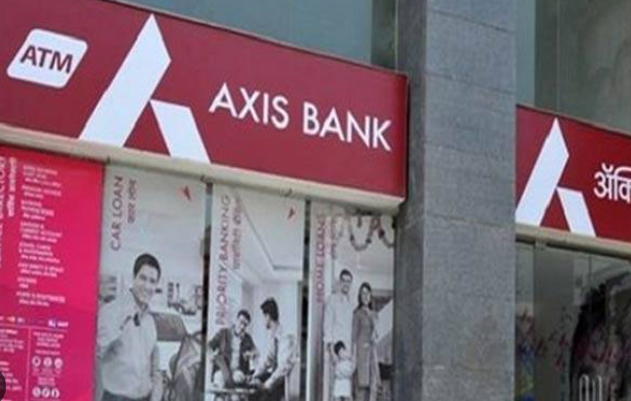Axis Bank has released its Q4 results, and the numbers are looking impressive. The bank reported a standalone net profit of Rs 7,130 crore for the March quarter, marking a significant increase from the previous quarter’s profit of Rs 6,071 crore (up 17% quarter-on-quarter). This is a remarkable turnaround from the same quarter last year when the bank reported a loss of Rs 5,728 crore.
One of the key highlights is the growth in Net Interest Income (NII), which rose by 11% year-on-year to reach Rs 13,089 crore for the quarter. Additionally, the Net Interest Margin (NIM) saw a slight improvement, coming in at 4.06%, up basis points quarter-on-quarter.
In a move to reward its shareholders, the Axis Bank board has recommended a final dividend of Re 1 per equity share, pending approval from the bank’s members at the upcoming 30th Annual General Meeting.
Furthermore, the bank has announced plans for fundraising, with a whopping Rs 55,000 crore earmarked for this purpose. This demonstrates the bank’s confidence in its future growth prospects and its commitment to strengthening its financial position.
Overall, Axis Bank’s Q4 results reflect a robust performance, showcasing its resilience and ability to navigate through challenging economic conditions. Investors and stakeholders can look forward to continued growth and value creation from one of India’s leading private lenders.
 Axis Bank other Income
Axis Bank other Income
Axis Bank’s non-interest income has shown significant growth in the latest quarter, reflecting a diverse range of revenue streams contributing to its overall performance.
Fee income surged by an impressive 23% year-on-year, reaching Rs 5,637 crore. What’s particularly noteworthy is the strong growth in retail fees, which rose by 33% year-on-year and accounted for 74% of the bank’s total fee income. Within the retail segment, fees from cards and payments saw a remarkable 39% year-on-year growth, while fees from other retail assets (excluding cards and payments) also saw a healthy 20% increase. Additionally, income from third-party products experienced a substantial 59% year-on-year growth.
Corporate and commercial banking fees, while growing more modestly at 2% year-on-year, still contributed significantly, totaling Rs 1,478 crore for the quarter.
Trading income added another dimension to the bank’s revenue, amounting to Rs 1,021 crore, while miscellaneous income added Rs 107 crore to the mix.
Overall, non-interest income, which includes fee income, trading income, and miscellaneous income, experienced remarkable growth of 41% year-on-year and 22% quarter-on-quarter, totaling Rs 6,766 crore for Q4FY24.
Provisions and contingencies These figures underscore Axis Bank’s ability to leverage a diverse range of revenue streams, with a strong focus on retail banking driving substantial growth in fee income. This diversified income base bodes well for the bank’s resilience and future performance in a dynamic market environment.
Axis Bank has provided insights into its provisions and contingencies for the fourth quarter of FY24, shedding light on its approach to managing risks and maintaining financial stability.
During Q4FY24, the bank allocated Rs 1,185 crore towards provisions and contingencies, with specific loan loss provisions amounting to Rs 832 crore. Notably, Axis Bank did not utilize its Covid provisions during this quarter, opting to reclassify them as other provisions. By the end of Q4FY24, the bank had set aside cumulative provisions totaling Rs 12,134 crore.
A key metric highlighted by the bank is its provision coverage ratio, which aggregates specific, standard, and other provisions. As of March 31, 2024, this ratio stood at an impressive 159% of Gross Non-Performing Assets (GNPA). Additionally, the credit cost for the quarter ending March 31, 2024, was reported at 0.32%. ALSO READ: Kotak Mahindra Bank shares crashed 10% today. Here’s fresh stock price target
Axis Bank NPAs, slippages Turning to asset quality, Axis Bank’s Gross Non-Performing Assets (NPA) decreased to 1.43% from 1.58% in the previous quarter, while Net NPA reduced to 0.31% from 0.36% quarter-on-quarter. Noteworthy is the bank’s recovery from written-off accounts during the quarter, amounting to Rs 919 crore.
These figures underscore Axis Bank’s proactive approach to managing asset quality and mitigating risks. With robust provisions and a healthy provision coverage ratio, the bank appears well-prepared to navigate challenges and maintain its financial resilience.
In the latest quarter, Axis Bank reported some key figures regarding its loan slippages, recoveries, and dividend announcements, shedding light on its financial performance and future plans.
Axis Bank dividend: Adjusted for recoveries from written-off accounts, the reported net slippages for the quarter amounted to Rs 398 crore. Notably, the retail segment accounted for Rs 1,061 crore of these slippages, while the Commercial Banking Group (CBG) and Wholesale segments showed negative slippages, indicating an improvement. Gross slippages during the quarter totaled Rs 3,471 crore, showing a slight decrease from the previous quarter and the same period last year. Recoveries and upgrades from Non-Performing Assets (NPAs) amounted to Rs 2,155 crore, while the bank wrote off NPAs totaling Rs 2,082 crore.
On the dividend front, the bank’s board recommended a final dividend of Re 1 per equity share, pending approval at the upcoming Annual General Meeting. If approved, the dividend will be disbursed within 30 days from the conclusion of the AGM.
In terms of fundraising, Axis Bank announced plans to raise up to Rs 55,000 crore through the issuance of debt instruments and equity shares. This includes various instruments such as long-term bonds, masala bonds, and convertible debentures. The bank aims to utilize these funds to strengthen its capital base and support future growth initiatives.
However, analysts have pointed out a potential near-term concern regarding the increase in equity supply, which could impact the bank’s share price performance. Recent block deals have already contributed to this supply, raising considerations about how it might affect investor sentiment moving forward.
Overall, Axis Bank’s strategic decisions and financial results provide insights into its efforts to maintain stability, support growth, and create value for shareholders in the dynamic banking landscape.






Explore the thrill of Lucky Jet and dominate the game.